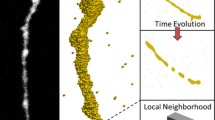Abstract
Kinetic Monte Carlo (KMC)-based stochastic model is used to understand the growth of zinc oxide nanowires from aqueous solution containing chemical precursors and capping agent. Through a hydrothermal growth mechanism, the average diameter of zinc oxide wires obtained is around 300 nm, whereas the length is order of several micrometers. Our Monte Carlo algorithm is based on the continuous-time Monte Carlo algorithm of Bortz, Kalos and Lebowitz (BKL) methodology. Both reactions and diffusion mechanisms assigning stochastic probabilities have been simulated. In algorithm, the ZnO atoms were treated as individual particles which diffuse in solution substrate and interact with other type of atoms. Once attached with growing nanowires, the diffusion rate of ZnO atom is considerably reduced. Since in a KMC algorithm each atom can be represented individually therefore, internal noise is automatically incorporated.









Similar content being viewed by others
References
Abhilash S, Hemant CW, Mats B, Joy deep DJ (2006) Zinc oxide nanowires in chemical bath on seeded substrates: role of hexamine. J Sol-Gel Sci Technol 39:49–56
Anthony SP, Lee JI, Kim JK (2007) Tuning optical band gap of vertically aligned ZnO nanowire arrays grown by homoepitaxial electrodeposition. Appl Phys Lett 90:103107
Battaile CC (1998) Atomic-scale kinetic Monte Carlo simulations of diamond chemical vapor deposition. PhD Thesis, University of Michigan, pp 147–170
Battaile CC, Srolovitz DJ (2002) Kinetic Monte Carlo simulation of chemical vapor deposition. Annu Rev Mater Res 32:297–319
Boercker JE, Schmidt JB, Aydil ES (2009) Transport limited growth of zinc oxide nanowires. Cryst Growth Des 9(6):2783–2789
Chang CP, Fan YZ, Chien JC, Stichtenoth D, Ronning C, Lu G (2006) High-performance ZnO nanowire field effect transistors. J Appl Phys Lett 89:133113–133115
Chen G (1998) Thermal conductivity and ballistic phonon transport in cross-plane direction of super lattices. Phys Rev B 57:14958–14973
Chen G, Borca T, Yang GR (2004) Encyclopedia of nanoscience and nanotechnology, vol 7. American Scientific Publishers, Stevenson Ranch, CA, pp 429–459
Fischetti MV, Lai VM, Laux SE (1993) Monte Carlo study of electron transport in Si inversion layers. Phys Rev B 48:2244–2245
Grafoute M, Labaye Y, Calvayrac F, Grenèche JM (2005) Structure of grain boundaries in nanostructured powders: a Monte Carlo/EAM numerical investigation. J Eur Phys 45:419–424
Greene L, Law M, Goldberger J, Kim F, Johnson J, Zhang Y, Yang P (2003) Low-temperature wafer-scale production of ZnO nanowire arrays. Angew Chem 42:3031–3034. doi:10.1002/anie.200351461
Howell RJ (1998) The Monte Carlo method in radiative heat transfer. J Heat Transf 120:547–560
Jacoboni C, Reggiani L (1983) The Monte Carlo method for the solution of charge transport in semiconductors with applications to covalent materials. Rev Mod Phys 55:645–705
Law M, Greene LE, Johnson JC, Saykally R, Yang P (2005) Nanowire dye-sensitized solar cells. Nat Mat 4:455–459
Lugli P, Bordone P, Reggiani L, Rieger M, Kocevar P, Goodnick MS (1989) Monte Carlo studies of non equilibrium phonon effects in polar semiconductors and quantum wells. Phys Rev B 39:7852–7865
Majumdar A (2004) Thermoelectricity in semiconductor nanostructures. Science 303:777–778
Ming Shan J, Ronggui Y, Gang C (2005) Monte Carlo simulation of thermoelectric properties in nanocomposites. In: 24th International conference on ICT, vol 19, pp 21–26
Rossnagel S, Ulman A (1996) Modeling of film deposition for microelectronic applications. Thin Films 22:290–291
Su WY, Huang JS, Lin CF (2008) Improving the property of ZnO nanorods using hydrogen peroxide solution. J Cryst Growth 310:2806–2809
Vayssieres L (2003) Growth of arrayed nanorods and nanowires of ZnO from aqueous solutions. Adv Mater 15:464–466
Vugt KVL, Ruhle S, Ravindran P, Gerritsen CH, Kuipers L, Vanmaekelbergh D (2006) Exciton polaritons confined in a ZnO nanowire cavity. Phys Rev Lett 97:147401
Wu JJ, Liu CS (2002) Low-temperature growth of well-aligned ZnO nanorods by chemical vapor deposition. Adv Mater 4:215–218. doi:10.1002/1521-4095(20020205)14:3
Zeyan W, Baibiao H, Xiaojing L, Xiaoyan Q, Xiaoyang Z, Jiyong W, Peng W, Shushan Y, Zhang Q, Yang X (2008) Photoluminescence studies from ZnO nanorod arrays synthesized by hydrothermal method with polyvinyl alcohol as surfactant. J Mater Lett 62:2637–2639
Zhang J, Sun L, Pan H, Liao C, Yang C (2002) ZnO nanowires fabricated by a convenient route. New J Chem 26:33–34
Zhang H, Du N, Wu J, Ma X, Yang D, Zhang X, Yang Z (2007) A novel low-temperature chemical solution route for straight and dendrite-like ZnO nanostructures. J Mater Sci Eng B 141:76–81
Acknowledgment
This work was supported by National Science Foundation through NSF Grant no. 2103-1016.
Author information
Authors and Affiliations
Corresponding author
Rights and permissions
About this article
Cite this article
Alvi, F., Joshi, R.K., Huang, Q. et al. Coarse-grained kinetic scheme-based simulation framework for solution growth of ZnO nanowires. J Nanopart Res 13, 2451–2459 (2011). https://doi.org/10.1007/s11051-010-0137-6
Received:
Accepted:
Published:
Issue Date:
DOI: https://doi.org/10.1007/s11051-010-0137-6




